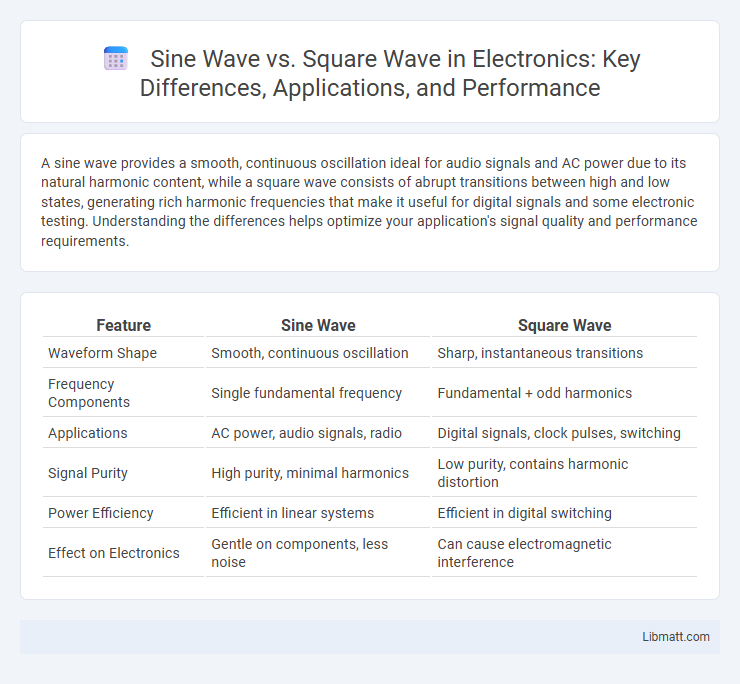A sine wave provides a smooth, continuous oscillation ideal for audio signals and AC power due to its natural harmonic content, while a square wave consists of abrupt transitions between high and low states, generating rich harmonic frequencies that make it useful for digital signals and some electronic testing. Understanding the differences helps optimize your application's signal quality and performance requirements.
Table of Comparison
| Feature | Sine Wave | Square Wave |
|---|---|---|
| Waveform Shape | Smooth, continuous oscillation | Sharp, instantaneous transitions |
| Frequency Components | Single fundamental frequency | Fundamental + odd harmonics |
| Applications | AC power, audio signals, radio | Digital signals, clock pulses, switching |
| Signal Purity | High purity, minimal harmonics | Low purity, contains harmonic distortion |
| Power Efficiency | Efficient in linear systems | Efficient in digital switching |
| Effect on Electronics | Gentle on components, less noise | Can cause electromagnetic interference |
Introduction to Waveforms: Sine Wave vs Square Wave
Sine waves are smooth, periodic oscillations characterized by their continuous and symmetrical shape, fundamental in representing natural harmonic signals. Square waves consist of abrupt transitions between high and low levels, creating a waveform with a distinct, non-sinusoidal pattern rich in odd harmonics. These inherent differences in waveform shape influence signal processing applications, audio synthesis, and electronic circuit design.
Fundamental Properties of Sine Waves
Sine waves exhibit smooth periodic oscillations characterized by a single fundamental frequency and continuous harmonic spectrum with amplitudes decreasing proportionally to the inverse of harmonic order. Their energy is concentrated at the fundamental frequency, resulting in minimal distortion and pure tone quality essential for signal processing and communications. In contrast to square waves, which contain multiple odd harmonics causing abrupt transitions, sine waves provide clean, predictable waveforms ideal for analyzing linear systems.
Key Characteristics of Square Waves
Square waves feature a distinct shape characterized by instantaneous transitions between high and low voltage levels, creating sharp edges and a constant amplitude. Their harmonic content includes odd harmonics with decreasing amplitude, which significantly affects signal processing and electronic circuit behavior. Your choice of a square wave impacts applications requiring precise timing and digital signal representation due to its predictable switching properties.
Generation Methods: How Sine and Square Waves Are Produced
Sine waves are generated using analog methods such as oscillators like the Wien bridge or crystal oscillators, which produce smooth, continuous periodic signals by varying voltage or current in a sinusoidal pattern. Square waves are typically produced through digital circuits including flip-flops, multivibrators, and microcontrollers, which switch rapidly between high and low voltage states to create sharp transitions and a rectangular waveform. Both waveform generation methods are fundamental in signal processing, electronics testing, and communication systems due to their distinct harmonic contents and applications.
Frequency Content and Harmonics Comparison
Square waves contain a fundamental frequency accompanied by a series of odd harmonics with amplitudes inversely proportional to the harmonic order, resulting in a rich harmonic content that contributes to their sharp, buzzy sound. In contrast, sine waves consist of a single pure frequency without any harmonics, producing a smooth and clean tone. This difference in frequency content makes square waves ideal for applications requiring a complex timbre, while sine waves are preferred for pure tone generation and signal analysis.
Applications of Sine Waves in Real-World Systems
Sine waves are fundamental in real-world systems such as AC power distribution, where their smooth oscillations ensure stable and efficient energy transmission. In audio engineering, sine waves serve as pure tones for testing and signal processing, enabling clear sound reproduction and analysis. Your electronics and communication devices rely on sine waves for generating carrier signals, modulating data, and minimizing harmonic distortion in transmissions.
Common Uses of Square Waves in Electronics
Square waves are predominantly used in digital electronics for clock signals and timing references due to their rapid transitions between high and low states, enabling precise control of circuits. They serve as carrier signals in pulse width modulation (PWM) for motor control and audio synthesis, where varying the duty cycle adjusts power or sound characteristics. Square waves also drive switching power supplies and are fundamental in generating pulse trains for communication systems and waveform testing.
Efficiency and Energy Implications
Sine waves provide higher energy efficiency in electrical systems due to their smooth, continuous waveform, resulting in less harmonic distortion and reduced heat generation in devices. Square waves, while easier and cheaper to produce, often cause increased energy losses and electromagnetic interference, leading to inefficiencies in power transmission and electronic component lifespan. Optimizing power supplies with sine wave outputs improves overall system reliability and reduces operational energy costs.
Advantages and Limitations of Each Waveform
Sine waves produce smooth, continuous signals ideal for audio and communication due to minimal harmonic distortion, but their generation requires more complex circuitry and precise control. Square waves offer easy generation and strong harmonic content for digital and switching applications, yet they introduce significant noise and electromagnetic interference. The choice between sine and square waves depends on desired signal purity versus ease of generation and application-specific harmonic requirements.
Choosing the Right Waveform for Your Application
Choosing the right waveform for your application depends on factors such as signal clarity and power efficiency. Sine waves provide smooth, continuous signals ideal for audio and RF transmissions, minimizing harmonic distortion and interference. Square waves deliver sharp transitions useful in digital circuits and switching power supplies where precise timing and high-frequency content are essential.
Sine Wave vs Square Wave Infographic

 libmatt.com
libmatt.com